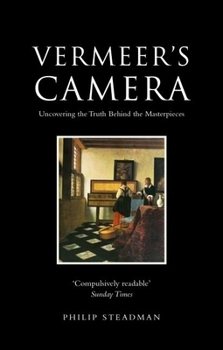Vermeer's Camera: Uncovering the Truth Behind the Masterpieces
Select Format
Select Condition 
Book Overview
Art historians have long speculated on how Vermeer achieved the uncanny mixture of detached precision, compositional repose, and perspective accuracy that have drawn many to describe his work as "photographic." Indeed, many wonder if Vermeer employed a camera obscura, a primitive form of camera, to enhance his realistic effects?
In Vermeer's Camera, Philip Steadman traces the development of the camera obscura--first described by Leonaro da Vinci--weighs...
Format:Paperback
Language:English
ISBN:0192803026
ISBN13:9780192803023
Release Date:September 2002
Publisher:Oxford University Press, USA
Length:224 Pages
Weight:0.84 lbs.
Dimensions:0.6" x 6.3" x 9.2"
Related Subjects
Art Arts, Music & Photography History History & Criticism Individual Artists PhotographyCustomer Reviews
4 ratings
Well researched and tolerably convincing
Published by Thriftbooks.com User , 18 years ago
This is a very well researched book. The author has taken great pains to measure and analyze Vermeer's paintings, finding a striking feature that many of them, when back-projected through the perspective view point at the size of the painting, imply a consistent location of a back wall to the common room used in the pictures. The author asserts that the only reasonable explanation for this coincidence is that Vermeer used a camera obscura for at least some of the layout of his paintings. This comes off as very plausible, though the analysis is limited to paintings that include a tiled floor. It would have been interesting to see this work extended through photogrammetry of objects of known sizes in the paintings (chairs, musical instruments, etc) and applied to more of the paintings. I think the only real failing in the argument is that Vermeer could have could have had the skill to paint perspective of this quality, and therefore not needed the aid of a camera. As pointed out in the text, he was not bound to perfect accuracy; there are some deviations.
Interesting, scholarly study
Published by Thriftbooks.com User , 19 years ago
Did Vermeer use optical aids, like a camera obscura, in crafting his wonderful paintings: yes or no? That is the question being asked here. This is a technical question, only, it adds or detracts nothing in Vermeer's ouvre and career either way. It's and interesting question though, and even an important one. What choices did Vermeer make in achieving greatness? Steadman convincingly argues that Vermeer very likely used a camera obscura, in one form or another, in creating many of his paintings. This work starts with a thorough discussion of the inconclusive written records. Vermeer was certainly contemporary to people like van Leeuwenhoek, who pioneered microscopy, even lived in the same city at the same time. He had long exposure to trades where lenses were used regularly, and lived in a time when lenses were available commercially. All that is circumstantial and, unlike other authors, Steadman declines to read more into available facts than they said in the first place. His real contribution is in his detailed analyses of Vermeer's paintings and their geometries, and in actual reconstructions of the rooms Vermeer portrayed and tools he might have used. This is the scientific method at work: present a falsifiable hypothesis, and create an experiment that confirms or denies it. "Is shadow in 'The Music Lesson' a credible, literal rendering of an actual scene?" His experiments from the late 80s, rebuilding rooms that match Vermeer's says "Yes." This is a delightful contrast to armchair guesswork by others, such as Wheelock, who never really checked but thought the shadows looked false. This is a worthwhile historical and technical achievement, partially funded by the BBC for a TV special in 1989. It also stands in clear contrast to Hockney's later work on much the same question, "Secret Knowledge." Hockney asked, as an artist, do these tools give me the experience captured in the old masters' art? His answer, achieved by personal immersion, was also "Yes." I respect Steadman's rigor as a historian and experimentalist, but this work comes off a bit dry compared to Hockney's first-person report. It's an interesting book on an artist about whom maddeningly little is known. It's thorough, and gives future art historians a very high bar to clear. If not for the hands-on liveliness of Hockney's book, I might have ranked this one even higher. //wiredweird
A Detective Story for Vermeer Lovers
Published by Thriftbooks.com User , 20 years ago
This treasure is actually a mystery novel in the guise of an art book! Steadman cleverly examines the long-held debate over Vermeer's alleged use of camera-like inventions to help create his masterworks. He does so by constructing models of the rooms, examining long-overlooked clues and engaging in some very pragmatic thinking. At times Steadman almost comes across as art history's answer to Lt. Colombo, which is a compliment. This is a very readable and enjoyable book for any art lover who also loves a good mystery, brain teasers, and practical application of optics. My only quibble is that additional illustrations and plates would have helped Steadman make his point better.
Did He or Didn't He?
Published by Thriftbooks.com User , 23 years ago
Did the famous Delft artist, Johannes Vermeer, use the camera obscura to create his remarkably photographic paintings? People have been asking that question for a century or more. To help answer it, Philip Steadman has written this great little book. It is truly an enjoyable investigation of Vermeer's acquaintances, studio, and style. My favorite parts of the book are Steadman's photographic reconstructions of Vermeer's paintings. Did Vermeer use the camera? If he did, would that make him an artistic cheat or a visionary? I like a book that leaves me with some things to think about, and this one does the job.






